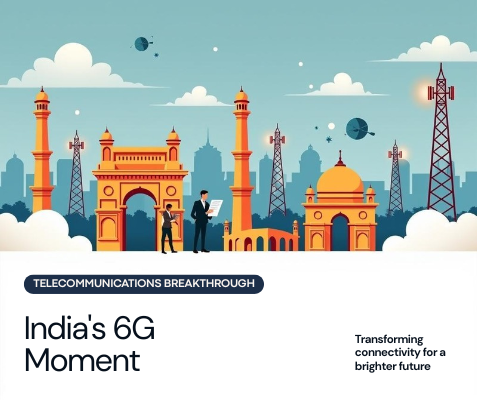India’s 6G Moment – The Delhi Declaration That Turned Roadmaps into a Plan

The Yashobhoomi convention centre in New Delhi hummed like a living machine — not because of racks of servers on display, but from the cautious optimism of engineers, regulators, and telecom leaders. Amid panels and whitepapers at India Mobile Congress 2025, the Bharat 6G Alliance and nine international bodies signed the Delhi Declaration — a principles pact that declared security, openness, resilience and inclusion as the guiding stars for the next generation of wireless networks.
If 5G was mostly about faster consumer services, 6G is shaping up to be structural: AI-native network control, smooth handoffs between terrestrial and satellite links, and sustainability built into radio and data center lifecycles. The Delhi Declaration does not define technical specs — it sets the ethical and engineering frame that will shape how those specs get written. In practice, that makes it a politically useful and technically significant document.
“The Declaration is a compass — it won’t write code, but it will tell engineers and policymakers which path to prioritize.” — industry participant (paraphrase).
Why now? Three converging forces made the moment inevitable. First, institutional muscle: the Bharat 6G Alliance, TSDSI and allied groups have shifted from talk to deliverables — creating working groups and lining up international partners. Second, the satellite imperative: collaborations with bodies like ESA mean 6G will include non-terrestrial networks as a baseline, not an add-on. Third, political appetite — policymakers are publicly aiming to capture a significant share of 6G patents and to align incentives for domestic manufacturing and testbeds.
What the Delhi Declaration commits to
Signatories agreed to a set of principles rather than technical rules: secure-by-default architectures, open standards to avoid vendor lock-in, inclusive designs that serve rural and low-power contexts, and sustainability goals that reduce energy footprints across the network stack. These principles will guide later debates about waveforms, AI control loops in the network core, and how satellites and terrestrial networks hand off sessions.
Partnerships and practical deals
Diplomacy met engineering on stage: aside from declarations, the Alliance signed MOUs with international partners (notably with ESA for satellite-terrestrial trials) and mapped out partnerships with domestic institutes, including plans to involve IIITs and state testbeds. The idea is to stitch together distributed R&D: local labs, global research collaborators, and pilot networks that can test AI-native orchestration and non-terrestrial redundancy.
The Declaration will be tested in real labs. Expect pilot testbeds in 2025–26 that stitch satellite links, edge compute, and AI orchestration. If those pilots succeed, the 3GPP and ITU standardization debates from 2026–2028 will be fought from a stronger Indian position — with patentable contributions and experimental evidence to back claims.
Short roadmap — to watch
- 2025–2026: Multi-party pilot testbeds, ESA trials, and initial manufacturing policy moves.
- 2026–2028: Standards contributions at 3GPP/ITU and patentable components emerge from testbed learnings.
- 2026–2030: PLI and manufacturing incentives may enable radio and sensor assembly; success depends on stable supply chains and international collaboration.
Risks & friction points
The technical and political challenges are real: standardization is competitive and can privilege specific IP-holders, satellite integration raises spectrum and roaming complexities, and manufacturing requires large capital and secure supply chains. Moreover, AI-driven network decisions will need governance frameworks to be trusted. The Declaration points to these risks but solving them will take more than principles — it will need funded partnerships and open evaluation frameworks.
Why businesses should care
For startups, this opens product spaces: satellite-enabled IoT, AI-managed private networks, and green radio-planning tools. Operators get a chance to become platforms for edge AI workloads and non-terrestrial redundancy. For vendors, India’s policy incentives could tip the business case for local assembly or fabs. For universities, it’s an invitation to co-own research and produce patentable output.
FAQ
Q: What is the Delhi Declaration?
A: A principles-based pact signed by the Bharat 6G Alliance and nine international bodies to prioritise secure, open, resilient and sustainable approaches in early 6G work.
Q: Are satellites part of India’s 6G plans?
A: Yes — ESA collaboration and MoUs indicate satellite-terrestrial integration is a core part of the roadmap.
Q: When will we see pilot networks?
A: Pilot testbeds and trials are expected in 2025–2026; standardization and patent activity will ramp up afterwards.
The Delhi Declaration is not a final blueprint; it is a shared commitment and a directional signal. If testbeds validate the principles, and if India pairs policy with practical R&D, then the next five years could see the country move from consumer to co-author of next-generation wireless — with satellites, AI, and sustainability woven into the fabric.




